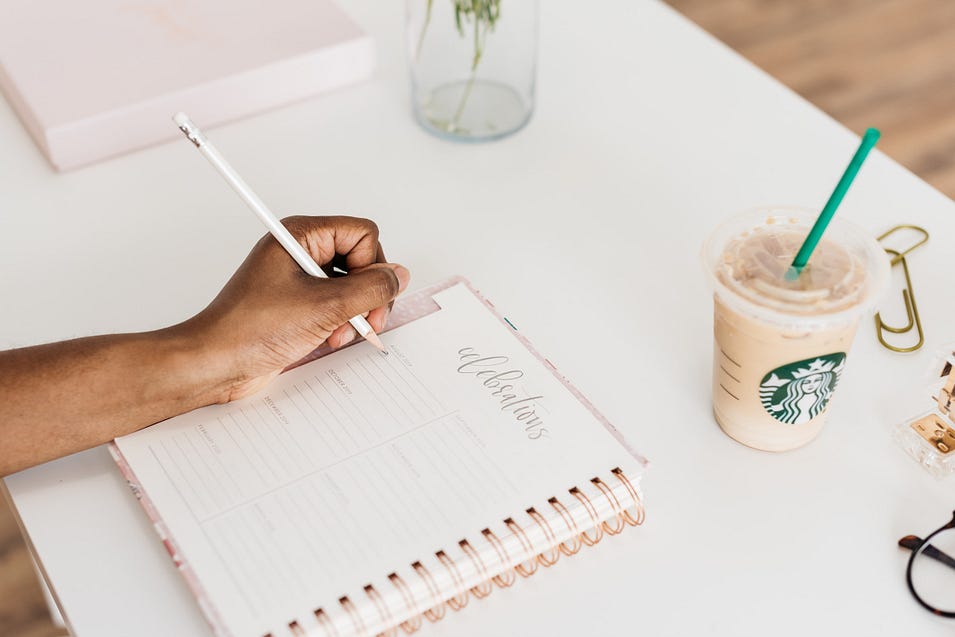How to Be Present If Your Mind Wanders

12 things that help me worry less and live in the moment
I have always been a daydreamer.
Yet, with the years, it turned into worry and a struggle with anxiety.
When my mind wanders, I used to feel like time is sleeping away. What frustrated me the most was my inability to experience the important moments in my life. I will be body present only and will not be able to recall conversations with loved ones.
I struggled to stay in the present moment.
Life responsibilities turned my daydreaming into constant worry about the future and the past.
There were moments where I will be deep in my mind, and I will miss life completely. It affected my motivation, and I would have zero interest in doing anything. Over the years, I have become more aware of how daydreaming affects the people around me, my career, and my day-to-day life.
For that reason, I have tried and implemented techniques that help me be more present moment and worry less.
Being in the present means that we are aware of what is happening in this very moment.
Many people, including myself, go through life sleepwalking. Being able to be more present or live more in the moment is not easy. Many things prompt us to leave the present and worry about things that have not even happened.
What worked for me might not work for you but give it a try. After trying many techniques, I have learned to use them interchangeably depending on the situation. I do not do all of them on the same day, but different ones at different times.
Do not get me wrong — I still have moments where I worry, feel anxious, or my mind wanders. But these moments are far less, and even if they happen, I am quick to catch myself and concentrate better on the present moment.
If you want to be more at the moment, worry less or not let your mind wander keep reading.
1. Be Clear Why You Want to Be Present
The “why” will motivate you and give you a purpose to continue trying different techniques. Some of these reasons for me are to spend quality time with my loved ones. I reminded myself to be in the present by asking — am I OK if I miss this moment? Is my email or TV more important than having a conversation with someone I care about?
You cannot be present 100 percent of the time. But you can choose what moments are important for you and be present for them.
2. Start Small
I used to get so anxious and frustrated by the number of techniques I wanted to try. At some point, I was so mechanical with them and was doing them for the sake of doing them, which was not the point. Thus, I stopped everything and focused on one. When someone is talking to me, I will leave my phone or laptop, turn my head, and listen.
It is easy to get overwhelmed by trying to do everything at the same time. You could pick one tip and continue doing it for at least a couple of weeks. If it does not work, try another one. Any new habits will take time to incorporate into your routine.
Do not get discouraged if a technique is not working for you. There are so many in this article. Living in the present was challenging for me at first. The best part is the tips are easy to do, and with time, you can only get better.

3. Work on Being Present Before Trying Mindfulness
Learning to be present and mindful at the time, if you have not done either, might be too much at first.
Being present and being mindful sound similar, but they are different.
- Being present means that you are engaging in what is happening right now.
- Mindfulness is a state where you acknowledge your thoughts, sensations, and feelings without judgment.
Being mindful builds on being present. You cannot be mindful without being present, but you can be present without being mindful.
Being mindful and present are two techniques that can help you be happier and more satisfied in life. But, if all this is new to you, start with being present.
I was first introduced to mindfulness and found it challenging to do. I was practicing it at the office where I was not present, and It was now working out. Now being mindful feels like the natural next step after learning to be present. I no longer need to try so hard as I did a few years ago.
4. Ask Yourself, “What Am I Doing Right Now?”
Then answer this question yourself. Once you answer it, you automatically dive into the present moment. For example, what am I doing right now? — Writing an article, typing on my laptop, looking at my screen. Almost like you are explaining it to someone who is not there with you.
This question acts as a trigger to snap me out of being too deep in my thought and come back into the present moment.

5. Narrate Your Life
Often when we wake up, our brain finds things to focus on within seconds. The moment I realize my mind starts to wander (especially if I procrastinate), I will begin to narrate my life. I love doing it when I wake up before all the plans for the day overwhelm my morning brain.
I will start by describing the actions that I am doing. For example, I’m waking up and sitting in my bed, I am looking for my slippers, I am walking towards the door, I open the door, etc.
Narrating your life is not something that you should be doing all the time. Instead, use it as a tool trigger to bring you to the present moment.
6. Focus on The Person in Front of You
This one is the most important one for me — my attention towards a conversation and my ability not to get distracted. When I am spending time with another person, I put effort into making them a priority.
The most important person is always the person with whom you are, who is right before you… The most important pursuit is making that person, the one standing at your side, happy, for that alone is the pursuit of life.
Leo Tolstoy, The Emperor’s Three Questions
When I am in others’ company, I have realized it is when I disappear from the present the most. I will go in my head thinking about my problems or plans.
It is challenging to be present for others when things distract you, like a TV or phone. If you cannot stop those distractions or have lots on your mind, it is better to postpone the conversation. I will often give heads up by saying, “I need to do this, or I cannot concentrate now; let me come back to you later.” Not doing it and being half there for your loved ones can be hurtful and even rude.
There is an effortless way to check if it happens to you by recalling a situation with another person. Try to remember specifics around the conversation or the place. What you might notice is that you cannot remember the details. You have a general memory that this happened, but you cannot recall anything else.

Maybe you were in your head thinking about something unrelated to that situation? It is the same when someone is telling you about their problems or something that happened to them. You are in your head, thinking about your problems or what you want to say next.
Instead, look at the person that is in front of you and actively listen. You can ask them questions and get to know them.
The best way to be interesting is to be interested.
People notice and appreciate when you are present with them, and they will enjoy your company. I am so aware of when I am doing it that I notice when someone else is doing it to me.
The moment I am on the receiving end, I do not even wait. I feel I am wasting my time if the person is listening but not paying attention. If the person is not present, I would completely stop the conversations and have it late or with someone else.
Redirecting your attention to the person in front of you can stop your mind from wandering and be present for the conversation. Training your brain to be present for the person in front of you will help your mind wander less.
A bonus benefit — you will start picking up on the body language of the people around you, like the tone of voice and eye contact. It has made me more in tune with people’s feelings.
7. Plan Your Future in Small Chunks
It is beneficial to create your balance between living in the moment while thinking about the past or the future. Many people believe that they need to stop thinking about the future or the past to be present, which is not true.
The key is to notice when you are doing it and be present with the thoughts.
When I am cleaning, often I’ll be thinking about future things I want to do. Within twenty minutes, I will misplace something and completely lose it. It may take me a couple of days to find it, and it is a classic example of me not being in the present.
But if I happen to think about Situation “X” tomorrow and I sit down to write the list. As long as I am actively thinking about my list's writing, I am present while planning for the future. There is no rule telling you problem-solving in the present is not allowed.
The same applies to the past when you revisit the lessons that you learned. Some tricks that you can use when thinking about the past:
- Be intentional. Why do you think about a specific moment? Is there something that you want to remember, or is it something you are trying to recall?
- Focus on small things or do it in small doses. For example, you are thinking about the future enough to be prepared but not to plan the whole year.
Mastering being present will help you live a life beyond the fears of the future and traumas of the past.
One way to know you are on the right track is to notice you worry less about things from the future or the past. Almost like — you are acknowledging them and then letting the worry go and focusing on the present.
I know following these steps might seem complicated. But being aware of it and noticing when you are doing it is the first step.

8. Notice Your Breathing
I will have many moments when things are not going to plan, where my mind will wander - to either look for solutions or escape the stress.
What I realized is when that happens, my breathing becomes irregular. When you are under stress, it can be difficult to recall any ‘’how to be present’’ tips. But if you can remember one, it will be — noticing your breathing.
I would try to hear myself breathing and start counting my breaths. Even if for seconds, it brings me out of my wandering mind back into the present moment.
When we focus our attention on our breathing, we have no choice but to be present.
Yoga is often recommended as a technique to be more present and mindful. It’s because of its focus on breathing.
If you want to take things to the next level, try the breathing exercise called 4–7–8. It is useful, especially when you are under stress or overwhelmed. This exercise is simple and takes no time to do it.
You can do it anywhere. You can have your back straight, but it is not mandatory.
- Fully exhale through your mouth by making a whoosh sound.
- Inhale through your nose to a mental count of four.
- Hold your breath to a mental count of seven.
- Exhale completely through your mouth, making a whoosh sound to a mental count of eight.
The above is one breath.
- Inhale again.
- Then repeat the cycle three more times for a total of four breaths.
What is important to remember is the ratio and do not do more than four breaths at a time. If you want to give it a try, you can do it twice a day for the next four weeks and see how you go.
In the beginning, you do not need to do more than four breaths at a time. After a month, you can increase to eight breaths.

9. Give Meditation a Try
A significant barrier to practicing meditation is the fear that it takes time and is hard. I avoided meditation for so long until I got so stressed out in the old job that I decided to give it a go.
Start with five minutes a day. It can be at any time of the day that you usually feel stressed or when no one will interrupt you.
- Close your eyes and be comfortable.
- Try not too comfortable, so you do not fall asleep.
- Keep the focus on your breathing for five minutes.
- Notice your breath coming in and coming out.
I had so many questions, and I was so unsure if I was doing it right or not. On top of that, I could not do it for more than 3 min. The thing that helped me was a ten-day challenge on the app Headspace with guided meditations.
Something that can be frustrating about meditation is, the more you try not to think, the more you end up thinking. But being OK with it and not judging yourself is a step towards being good at meditating.
Remember, do not be hard on yourself. This is a journey. And the more you do it, and the more you practice it, the better you will get.
If you find it difficult to meditate or not work for you, try focusing on one task at a time. For example, when you walk, walk, drink coffee, drink coffee when you talk to someone, you speak to that person. Trying to multitask can overwhelm your brain, and you could feel even more stressed.
10. Listen to Music for Focus and Concentration
Music used to distract me so much. I always wondered how people could do anything when these dance tunes are blasting at them?
One day I was writing in the living room when my brother was playing video games. It was one of those about the space. It was then that I noticed I had been thinking about this all wrong. I needed music with no vocal, slower but not so quiet, and not too many ups and downs.
You can find playlists on Spotify like Video Games soundtracks, Cinematic, or Binaural Sounds. There are some excellent playlists for focus and concentration.
I find it very helpful when I want to focus on a specific task to reduce the noise. For example, in an open office or even at home, people walk around, talk, or eat. The only thing that can bring me to the present moment is to get the headphones and play some of the mentioned playlists.
11. De-clutter Your Space
Clutter affects your mind by reminding you about things that you have not finished. Also, it’s tough to be in the present when you’re in a cluttered space. It was one reason why people leave the house “to think” because they cannot do it in a chaotic environment.
Even when you close the door of the room where you are storing away your clutter, you know it is there. Waiting for you.
You do not have to become a minimalist or go all in. Be honest about what places or things you want to clear out, get rid of, or organize.
Start by doing little bits every day. I used to target a whole room, which will take me hours (as I was getting distracted along the way). Tackling a big space to clean was not helping — instead, it was stressing me even more. I will feel that I am wasting my time and will get me all irritated and angry at the end.
A good trick I am have been doing is taming my cleaning.
- I got one of these external times, but you can use your phone.
- Set the alarm for 10 min.
- Clean as much as you can in 10 min only.
- As soon as the time is over, walk away.
It will surprise you how much you can clean when you have a deadline hovering on top of your head!
Doing little bits every other day will affect how your mind feels around this clutter. While I was working on mastering my cleaning routine, I came to the following solution. I will feel less worried if I learn to be OK with clutter. No joke — it has changed my life.
I am not saying do not clean. We cannot always have time to clean, so being fine to wait until you can, might be the better approach.
Cleaning is one of the best ways to procrastinate. So do a little bit of cleaning and start letting go of the stress clutter is causing you.

12. Tackle Your Mind List
We all have things that we want to do tomorrow or someday. The list keeps building and building in our minds, in our notes, in our notebooks. A great way to be present is to look not only at the clutter around you but the clutter on your to-do list.
I used to have so many notebooks, loose paper, apps, and even emails to myself with yet another to-do list. I was doing it to offload everything on my mind or the things I was dreaming of or planning to do.
Downloading my thoughts to free up brain memory helped for a while. Until I realized the lists had become so big and so many that it started stressing me out.
Thus, my new strategy is to do a brain dump and leave it on paper for a while.
- Then I will revisit it with clear, focused attention and be present for the review.
- I will ask myself, ‘’does it matter’’ and ‘’will I lose something if I don’t do each of these things’’. What difference is it going to make if I do?
Sometimes we get very overwhelmed by everything we keep in our heads. And I know not everyone likes to write their to-do list or things to do. But when we write something on paper, it relaxes our mind. It frees up space to think about other things.
Removing items from your to-do list is a better strategy than organizing everything on your to-do list.
Closing Thoughts
This is what worked for me, but you will know what will work for you only by trying. I hope my approach helps you to start living more in the present and worry less.
Be kind to yourself and take your time with it. You do not have to do everything at the same time.
Choose the things that are important to you now and focus on them. Remember to know why you are starting for the very first time. All these steps are incredibly easy to try. It will take time to incorporate them into your routine. But that is OK. Just stick with the ones that work for you.
If all the techniques mentioned are still too much for you, then start from here:
- Choose to focus on what you are doing now.
- Start to recognize when your thoughts drift from what you are doing.
- Notice if your thoughts are going in the past or the future.
- Try to figure out why and see if it is intentional.
- Can you do something about this “why”?
- If not — can you let it go and come back to the present?
The more you do this, the more you will realize when your mind wanders. It will help you understand at what moments to apply what techniques, the same way I learned.
The primary purpose of being present is to take part in your life without wandering into “what if” thoughts.
Sometimes unpleasant emotions come to us, and we do not want to experience them. If we cannot leave — we make our mind escape. From mindful, we turn into mindless. This is exactly when addictive behaviors or recreational drugs might come into play.
Try to remember this is not the solution. It is a delayed reaction, and later, you will have to deal with two things.
Look after yourself and if anything makes you anxious, be curious why and see if there is anything you can do about it.
Being in the present and experiencing every moment will train your brain to be more aware when you drift. You will learn to concentrate easier and treasure all the moments that are important to you.
